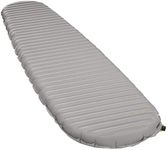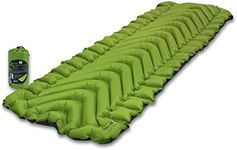Buying Guide for the Best Ultralight Sleeping Pads
Choosing the right ultralight sleeping pad is crucial for ensuring a comfortable night's sleep while minimizing the weight you carry on your outdoor adventures. The key is to balance comfort, insulation, and weight according to your specific needs and the conditions you'll be facing. Consider where and when you'll be using the pad, as well as your personal comfort preferences. Understanding the key specifications will help you make an informed decision.WeightWeight is a critical factor for ultralight sleeping pads, especially for backpackers who need to minimize their load. Sleeping pads can range from a few ounces to over a pound. If you're a minimalist or planning a long trek, aim for the lighter end of the spectrum, typically under a pound. However, if comfort is a priority and you're willing to carry a bit more weight, you might opt for a slightly heavier pad that offers more cushioning.
R-ValueR-Value measures the pad's insulation ability, indicating how well it can keep you warm. This is particularly important if you'll be camping in cold conditions. R-Values range from 1 to 10, with higher numbers offering better insulation. For summer camping, an R-Value of 1-3 is usually sufficient. For spring and fall, consider 3-5, and for winter camping, look for 5 or higher. Choose based on the lowest temperatures you expect to encounter.
ThicknessThickness affects both comfort and insulation. Thicker pads generally provide more cushioning and can be more comfortable, especially for side sleepers. Thickness can range from less than an inch to several inches. If you prioritize comfort and don't mind a bit more weight, opt for a thicker pad. For ultralight backpacking, a thinner pad might be preferable, but ensure it still offers adequate insulation for your needs.
MaterialThe material of a sleeping pad affects its durability, weight, and comfort. Common materials include foam, air, and self-inflating pads. Foam pads are durable and lightweight but may not be as comfortable. Air pads are comfortable and pack small but can be punctured. Self-inflating pads offer a balance of comfort and durability. Choose based on your preference for comfort versus durability and the conditions you'll be facing.
Packed SizePacked size refers to how small the pad can be compressed for transport. This is important for saving space in your backpack. Ultralight pads typically pack down very small, often to the size of a water bottle. If space is a premium, look for pads with a smaller packed size. Consider how much room you have in your pack and how much space you're willing to allocate to your sleeping pad.
















